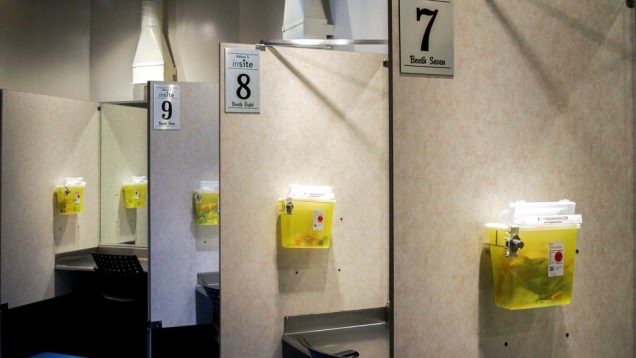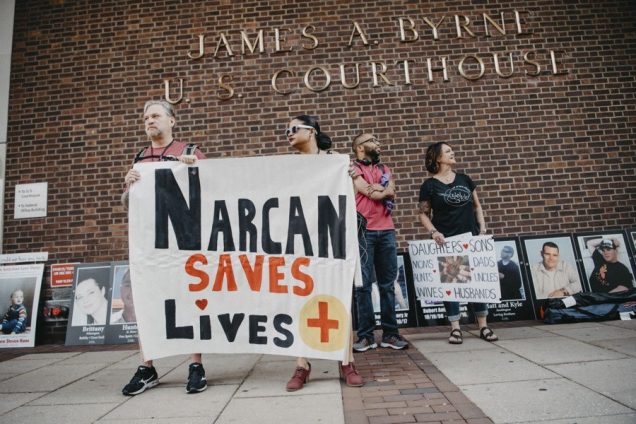Tagged: CDC
United States v. Safehouse: Could Philadelphia be the First State in the Nation to Implement a Supervised Drug Injection Site?
The opioid epidemic is one of the worst public health crises affecting the United States, and the rate of deaths resulting from opioid overdose has steadily increased. According to the Centers for Disease Control and Prevention, a record high of more than 70,000 people died of a drug overdose in the United States in 2017, and over 47,000 of those deaths were from opioid overdoses. As lawmakers attempt to address this epidemic through public health initiatives , health advocates increasingly recommend using supervised injection sites to curb overdose deaths. Though legal barriers to this in the US exist, a recent District Court ruling in United States v. Safehouse may have paved the way for implementation of the first site of this kind in the US.
Injection sites provide a space where those using intravenous drugs can inject under the supervision of a medical professional ready to intervene in the event of an overdose, instead of unsupervised use where an overdose is more likely to be deadly. Supervised injection sites, also called safe injection facilities or safe consumption spaces, are a tertiary preventative public health measure aimed at combating overdose deaths and decreasing public use. In these spaces, injection drug users can self-administer drugs they bring to the facility in a controlled, sanitary environment under medical supervision. The medical personnel on staff at the sites do not directly handle the drugs and are there purely to administer Naloxone, an overdose reversal drug, in case of an overdose.
Despite the growing global presence in Europe, Australia, and Canada, scientific support for safe injection sites, and the interest of several cities, including Philadelphia, Boston, New York, Seattle, and San Francisco it is not entirely certain they can be operated in the United States. The Controlled Substances Act § 856, which regulates the production, possession, and distribution of controlled substances, makes it a criminal offense to maintain a drug-involved premises. Most academics agree that this “Crack House” Statute forbids safe injection sites and the courts can not definitively decide if safe injection site violate federal law until one is operational.
However, recently these assumptions have been called into question. Safe injection site proponents in many states have been appealing to legislatures and public health officials for funding. This effort has been largely unsuccessful due to political opposition and the looming threat of a federal lawsuit. In Philadelphia, which has the highest overdose rate of any major US city, a poll found roughly half of Philadelphians support a proposed safe injection site. Safehouse is a Philadelphia nonprofit that seeks to build the first safe injection site in the nation. In January 2018, Philadelphia health officials gave Safehouse permission to move forward with only private funds—preventing the need for legislative backing and appropriations.
In February 2019, federal prosecutors launched a civil lawsuit asking the U.S. District Court to rule on the legality of the Safehouse supervised consumption site plan, rather than waiting for the site to be built and then bringing federal criminal charges. U.S. Attorney William McSwain, working with Pennsylvania-based prosecutors, is seeking a declaratory judgment that medically supervised consumption sites per se violate 21 U.S.C § 856(a)(2)— the federal “Crack House” statute.
In February 2020, the court issued United States v. Safehouse, ruling that Safehouse’s plan to build a site where people could bring previously obtained drugs and use them under medical supervision for the purpose of combating fatal overdoses does not violate the Controlled Substances Act. Judge McHugh, looking at Congressional intent, ruled that §856 “does not prohibit Safehouse’s proposed medically supervised consumption rooms because Safehouse does not plan to operate them ‘for the purpose of’ unlawful drug use within the meaning of the statute.” McHugh determines that at the time of enacting §856(a), Congress was focused on crack houses, not supervised drug injection sites. Even when amended in 2003, the focus was on “drug-fueled raves.” McHugh found that Congress neither expressly prohibited or authorized injection sites, so if §856(a) did not implicitly prohibit a consumption site, then implicit authorization naturally followed.
The question that the court addresses is whether the statute requires the defendant to know that third parties would enter their premises to consume illicit drugs, or rather that the defendant knowingly held their premises open for the purpose of facilitating illicit drug consumption. Judge McHugh concludes that the actor must “have acted for the proscribed purpose” to violate the statute. Therefore, the accused under a §856(a)(2) violation must have the purpose of facilitating illegal controlled substance use in the maintenance of a property.
Safehouse is planning “to make a place available for the purposes of reducing the harm of drug use, administering medical care, encouraging drug treatment, and connecting participants with social services.” The district court reasons that because of this, it could not conclude that Safehouse has, as a significant purpose, “the objective of facilitating drug use.”
In the wake of the ruling, U.S. Attorney McSwain announced that “this case is obviously far from over” and it is likely that the federal government will continue to litigate it. It is not unlikely that the Court that may hear this case on appeal disagrees with the District Court’s construction and strikes the legality of a supervised injection site based not on the intent of the person who controls the space, but the intent of the attendee of the site to use illicit drugs at that site, which has been the prevailing opinion up until the point of this ruling.
While the Safehouse case stands for an unexpected legal victory by way of the possibility of a supervised injection site to be opened in the United States, Philadelphia itself may not be the first state in the nation to implement one. The public sentiment in the wake of the decision was largely negative, with the local community being virulently opposed to the idea of a site being opened in the neighborhood from fear of what dangerous circumstances a site might attract. Plans to open the Safehouse site were put on indefinite hold. While proponents of Safehouse won the legal battle, winning over the community seems to be more of uphill battle than anticipated.
At this point in time, the legal position of supervised injection sites in the United States is tentatively positive. States who are looking to introduce this harm reduction initiative, and to be the first in the nation to do so, should take the opportunity to garner support from legislatures and local health care communities. While Philadelphia’s progression seems to be stymied, the District Court’s ruling provides significant legal precedent to ground encouragement for sites to be lobbied for in other states or cities that might not face the same type of community rejection that has prevented the opening of Safehouse.
 Zahraa Badat anticipates graduating from Boston University School of Law in May 2021.
Zahraa Badat anticipates graduating from Boston University School of Law in May 2021.
Pharmacies Try Their Hand at Opioid Policy
The opioid crisis has continued to grab national attention, as total drug overdoses hit yet another historic high in 2016. One of the nation’s largest pharmacies, CVS, recently joined the debate by announcing a new national opioid policy.
In February 2018, CVS started capping new opioid prescriptions at a seven-day supply. Additionally, CVS is limiting daily doses to 90 morphine milligram equivalents (MME) and requires medical providers to prescribe immediate-release opioids before attempting extended-release versions. The policy itself is unremarkable. CVS is merely adopting the CDC’s prescribing guidelines. In fact, 17 states have done the same or equivalent, including Massachusetts. And while it may appear strange for a retailer like CVS to forcibly limit its own sales, both pharmacies and pharmaceutical companies have faced a growing threat of litigation in recent years over the marketing and sale of prescription opioids.
Medical providers, chronic pain patients, and some drug policy experts have lodged a number of concerns in response to CVS’s new policy. These concerns not only identify some of the closely held interests in the opioid debate but also demonstrate the challenges of developing effective policy against a crisis that is rapidly evolving.
The Costs
Opioid policies fall into three main categories: preventive, treatment, and punitive. The CVS policy aims to prevent the development of new opioid use disorders (OUDs). In an effort to minimize unintended consequences, the policy carves out two administrative exceptions: first, doctors may request exemptions for certain patients, and second, employers and insurers can opt out of the program altogether. The CVS policy also aligns itself with CDC guidelines in exempting patients who are in “active cancer treatment, palliative care, or hospice care.”
While this may reassure cancer patients, other patients with chronic pain have expressed cause for alarm. For one, their access to opioids is already subject to an ongoing and heated debate within the medical community. Limited data on long-term opioid use for chronic pain management has bisected medical experts’ opinions on the evidence base, ethics, and ramifications of prescribing decisions. In 2016, the CDC entered the fray. While its guidelines recommend heavily individualized opioid treatment decisions, the CDC director placed his thumb on the scale by declaring that “[m]anagement of chronic pain is an art and a science. The science of opioids for chronic pain is clear — for the vast majority of patients, the known, serious, and too-often fatal risks far outweigh the unproven and transient benefits.”
Chronic pain patients disagree that the data are so clear-cut. Moreover, they allege that the national opioid narrative is eliciting a fear-based response among medical providers at a negative cost to their treatment. Chronic pain patients report that their providers increasingly treat them like “addicts,” an inappropriately stigmatizing term that in these cases also ignores critical diagnostic differences between substance dependency and a substance use disorder. The result can be forced reductions to a patient’s opioid prescription without warning (known as involuntary tapering) or in extreme cases a blanket office policy against prescribing opioids altogether. It is early days—too early for clear data in fact—but reports of patient suicides in the wake of involuntary tapering have already surfaced.
 The CDC does not expressly require a physician to involuntarily taper a patient off of opioids. In fact, the CDC vests the authority for such individualized prescribing decisions in physicians. However, the DEA, which grants physicians’ prescribing licenses, admittedly muddled that message when it proposed broad cuts to opioid production: a 25% decrease in 2017 and a 20% decrease in 2018. Moreover, punitive DEA actions against physicians regarding opioid prescription conduct increased fivefold between 2011-2016. While the penalties are clear and steep (including loss of medical licensure and criminal charges), what conduct triggers those penalties is less clear. Thus, the combination of liabilities without a clear safe harbor incentivizes an overly strict interpretation of federal policies in ways that may harm patients.
The CDC does not expressly require a physician to involuntarily taper a patient off of opioids. In fact, the CDC vests the authority for such individualized prescribing decisions in physicians. However, the DEA, which grants physicians’ prescribing licenses, admittedly muddled that message when it proposed broad cuts to opioid production: a 25% decrease in 2017 and a 20% decrease in 2018. Moreover, punitive DEA actions against physicians regarding opioid prescription conduct increased fivefold between 2011-2016. While the penalties are clear and steep (including loss of medical licensure and criminal charges), what conduct triggers those penalties is less clear. Thus, the combination of liabilities without a clear safe harbor incentivizes an overly strict interpretation of federal policies in ways that may harm patients.
Beyond the legal liabilities, physicians have also voiced concerns over the increasing intrusion of third parties into treatment decisions. The CVS policy allows a doctor to request exemptions for certain patients, but does not specify its criteria for granting exemptions or if there are caps on the number of exemptions a doctor may request or receive. Some doctors worry the additional administrative requirements to apply for CVS exemptions will burden already overtaxed primary care physicians, leaving patients with delayed or insufficient care. For example, one study found that physicians already spend two hours on paperwork for every hour of treating patients. The CVS policy will increase that paperwork burden for physicians who choose to file for opioid patient exemptions.
Without further research on long-term opioid use, clear safe harbors for prescribing compliance, and a significant increase in the number of medical specialists trained in pain management, some patients and doctors share the concern that this prevention policy will come at unintentional costs to patients with chronic pain.
The Benefits
Much of policy derives from a cost-benefit analysis. If prescription opioids are the source of most new cases of OUDs, then some risk to patients with opioid dependencies (like those managing chronic pain) may arguably be worth strictly limiting their supply. Thus, the $78.5 billion question remains: are prescription opioids presently the main cause of new OUD cases?
A growing subset of drug policy experts say no. While prescription opioids undoubtedly contributed to the opioid epidemic in the past, recent data show that opioid prescriptions continuously decreased from 2010-2015. During that same time span however, opioid mortalities continuously increased. In fact, heroin increasingly represents the initiating opioid of use for new OUD cases, not oxycodone or other prescriptions. These data suggest that the over-prescription of opioids has been largely corrected and that new and stricter prescription limits moving forward may offer only marginal benefits.
The debate over CVS’s initiative mirrors many of the challenges of developing effective opioid policy at the state level. The opioid epidemic is rapidly evolving whereas drafting and passing legislation can take years to accomplish. In that same time span, the drop in prescription rates between 2010-2015 as well as the emergence of heroin as an initiating opioid have shifted the opioid epidemic, throwing into question just recently passed prescription-focused legislation. In short, the opioid crisis is both testing and demonstrating the limits of the legislative process.
Second, even if a legislature could sustain a multi-decade focus on continually revising opioid legislation, any attempt to do so effectively would require massive data gathering. Currently however, state medical examiners have already passed their breaking points, whether from running out of room, running out of money, or burnout. Yet these examiners play a crucial role in accurately identifying the cause of death for overdoses. Thus, even accurately tracking changes in cause of death alone would necessitate a massive influx of resources, in terms of additional personnel, time, and training for standardization. Beyond tracking overdoses, states would furthermore have to allocate additional resources to continuously monitor changes in initiating opioid use and to what extent supply limitations (like those currently placed on prescriptions) result in a substitute demand for more harmful illicit opioids like fentanyl.
Third and finally, the unintended effects of legislation matter just as much as the intended. A complex mesh of societal, punitive, and regulatory forces have created powerful disincentives for physicians to prescribe opioids or treat patients who need them. In particular, the stigmatization of chronic pain patients incentivizes withholding treatment for moralistic rather than medical reasons. The threat of criminal prosecution and loss of medical licensure incentivizes avoiding even relatively benign conduct for fear of triggering DEA or state investigation. Finally, the paperwork barriers formed by each new layer of regulatory compliance incentivize avoiding time-consuming patients, like those who require opioids. Thus, the exemptions that CVS and other state policies designed to safeguard individualized treatment decisions are likely insufficient to counterbalance the opposing disincentives. Effective policymaking requires a careful calculation of both direct and indirect incentives, far beyond the scope of a single prescription policy.
Going forward, CVS (and the states) should consider policy alternatives that expand provider choices rather than restrict them. For example, CVS could begin offering the abuse deterrent formulations (ADFs) of opioids. The FDA recommends ADFs as they offer the same pharmacological benefits as regular opioids but exist in a form that is harder to physically alter for off-label use. Currently, CVS does not cover any of the ten ADFs approved by the FDA. By offering a new prescriptive tool instead of restricting an existing one, this alternative might maintain some of the same intended preventive benefits without triggering an incentive to drop chronic pain patients.
Moreover, the addition of ADF coverage would allow for greater flexibility on a state level. Many states are in the process of or have recently completed crafting comprehensive legislative packages (including combinations of preventive, treatment, and punitive solutions). CVS’s uniform national policy may interfere with these efforts and make addressing unique state needs more challenging than necessary.
In summary, the benefits of CVS’s opioid policy are unlikely to outweigh its harms. The CVS policy provides no new guidance as it merely mimics the existing CDC policy, but it does add new layers of time-consuming compliance for providers pursuing medically-valid exemptions. Pharmacies and other retailers would do better to provide additional support to the existing state and federal opioid infrastructure than begin imposing new requirements upon it.
 Caitlin Scott anticipates graduating Boston University School of Law in May 2019 and plans to practice Health Law.
Caitlin Scott anticipates graduating Boston University School of Law in May 2019 and plans to practice Health Law.



